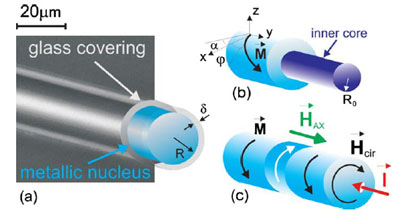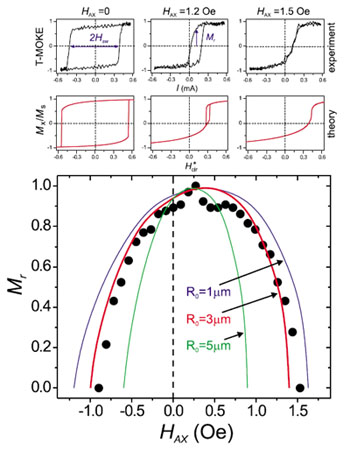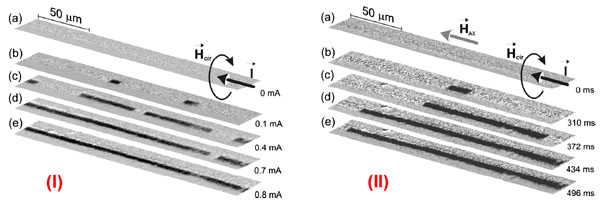Magnetization switching and domain structures in ferromagnetic microwires
Introduction
The physical properties of the ferromagnetic wires are being intensively studied in the latest decade. This is motivated by a need in deeper understanding of magnetism of low-dimensional systems [1]as well as by numerous possibilities of advanced technological applications [2].With controlled anisotropy, the magnetization states can be tuned, and a stable micromagnetic configuration can be promoted in micron or submicron wires, which are needed for advanced sensors and biomedical applications [2,4]. The importance of magnetic anisotropy is well recognized in tailoring micromagnetic configurations. Because of the interplay the shape axial, radial and circumferential anisotropies, and amorphous ferromagnetic wires exhibit a rich variety of domain line magnetic phases. These competing anisotropies originate in the distribution of internal stress which, depending on the thermal and/or mechanical prehistory of a wire, has axial, radial, and circumferential components.Thus, in a wire the actual distribution of stress-induced magnetic anisotropy is determined by the stress distribution as well as the sign and magnitude of magnetostriction. For example, for wires with negative magnetostriction axial anisotropy dominates in the inner core while circumferential anisotropy governs the magnetization in the outer shell.In such wires magnetization states represent either axially magnetized domains or circular and helical-like magnetization distributions.
Results
Intensive study of the magnetic properties of nearly zero magnetostriction Co-rich glass-covered microwires has been performed in relation with the giant magnetoimpedance effect. Moreover, ferromagnetic microwires can be used as model systems for the study of one-dimensional magnetic nanostructures.
The process of magnetization reversal in the surface area of the microwires has been studied by a MOKE loop tracer in transversal configuration and by MOKE optical microscope longitudinal configuration with the presence of a circular Hcir and axial magnetic field, Hax.

Image (a) and schematic configurations (b) of the wire with magnetization orientation, and schematic (c) of the circular domain nucleation and orientations of magnetic fields.

Top panel: the measured hysteresis loops and the loops -Mx /Ms vs Hcir – calculated from Eq.1 [6] for Hax =0, 1.2, and 1.5 Oe. Dependence of normalized remanent circular magnetization component Mr on the external axial magnetic field Hax (points). Lines are Mr calculated within the proposed model [6].
In low applied axial fields, on increasing the current (circular field), the initial left-handed chirality circular magnetization states undergoes the following phase sequence: a continuous transformation to a helical structure, then a jump to a helical state with opposite chirality, and finally, gradual rotation of the magnetization to a right-handed chirality circular state [6]. An applied axial magnetic field smooths the jump between the states with opposite chiralities and makes the magnetization states asymmetrical.

Images of circular magnetic domain structure transformation in the presence of electric current without (I) and with HAX=0.27Oe axial magnetic field recorded at different times (II) [5].
Using an axial magnetic field as a unique external parameter we have achieved that the surface magnetization reversal is realized in the form of a sharp giant Barkhausen jump in magnetic microwires [5]. This jump is characterized by the quick motion of the solitary domain wall which overpasses long distances of approximately hundreds of micrometers.
Reference
A. Masseboeuf, O. Fruchart, J. C. Toussaint, E. Kritsikis, L. Buda-Prejbeanu, F. Cheynis, P. Bayle-Guillemaud, and A.Marty, Phys. Rev. Lett. 104, 127204 (2010).
M. Vázquez and A. Hernando, J. Phys. D: Appl. Phys. 29, 939 (1996).
A. Hultgren, M. Tanase, C. S. Chen, G. J. Meyer, and D. H. Reich, J. Appl. Phys. 93, 7554 (2003).
4D. S. Choi, J. Park, S. Kim, D. H. Gracias, M. K. Cho, Y. K. Kim, A. Fung, S. E. Lee, Y. Chen, S. Khanal, S. Baral, and J.-H. Kim, J. Nanosci. Nanotechnol. 8, 2323 (2008).
A. Chizhik, A. Stupakiewicz, A. Maziewski, A. Zhukov, J. Gonzalez, and J. M. Blanco, Appl. Phys. Lett. 97, 012502 (2010).
A. Chizhik, V. Zablotskii, A. Stupakiewicz, C. Gómez-Polo A. Maziewski, A. Zhukov, J. Gonzalez, J.M. Blanco, Phys. Rev. B 82, 212401 (2010).
